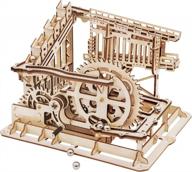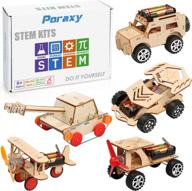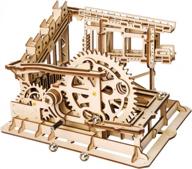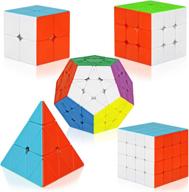
Review on 🎉 ROKR Mechanical Building Supplies: Top Choice for Birthday Parties by Lokesh Das

Mind Game Review and Tips
This was an incredibly interesting and only occasionally disappointing build kit for me. I'm happy to recommend it, although I highly recommend reading a few reviews and watching a few videos before buying or attempting to build it. The effort involved is difficult to estimate: Firstly, all the details are pre-cut - everything - even the rods for the dowels do not have to be cut to size, the post-processing is only done by grinding the burrs and lapping. Wax on multiple surfaces. But in many cases the parts are very fragile and the gear assemblies JUST need to be done RIGHT or they just won't work. There's no glue, no nails, no screws - everything slides, snaps, and holds together through friction and tension. This has its pros and cons. You can gently pry the pieces apart with a small screwdriver if you find you've misplaced the gear (not that that's happened to me! And certainly not twice!), but you'll need to use significant pressure to fully engage the latches to lock wooden parts. . Which brings me to my first key piece of advice: Think *carefully* about what you're pressing and how you can knock off other parts if you're pressing too hard. These are wooden parts; they can break. Push from the center of the gear, not the edges. On top of the metal rods that hold the gears at a very precise spacing, you will place many plastic washers. Be careful not to dislodge them when assembling the watch. I ended up denting both of my gears a bit as I built the frame around them, moved the spacers and suddenly messed everything up. It wasn't the end of the world, but I did have to carefully remove the gears, remove the washers, and reinstall them to spec. Tip #2: Check your work as you go. Once you've reached final assembly, each added gear should rotate freely without falling out of its socket, and the gears should mesh without binding or skipping. Enjoy the clockwork assembling movement after movement - it's a fun process - and stop, check your work and come back if something seems wrong. Removing pieces of wood from the panels that contain them must be done slowly and carefully. carefully. Don't try to force anything. Work around the pieces, rocking them a little at a time until they're loose. Don't remove the part until you need it - it's a lot easier. You can use some of the included sandpaper to smooth down any burrs on the parts (and yes, the included sandpaper was enough for me) but be careful not to sand the edges of the joints or they won't be in place when reassembled and hold position. You may notice that some gears or other parts are slightly warped. If so, then they can be wedged between two boards for a day or two. I had a slightly warped gear, but that didn't stop the clock from running - but I wouldn't mind taking the time to straighten it. There are extras for a number of parts in case you damage or lose them. Often, but not always, additional parts are outlined with a dotted line on parts sheets. Now the instructions. Well, the good times and the bad. There are no words past the first page, and at a few points I would certainly welcome some. Think IKEA furniture, and if that thought scares you, it might not be for you (I love IKEA!). The illustrations are very detailed and overall very high quality. Take the time to understand what each instruction requires. You can look forward, look back, put it off for an hour and go for a walk, whatever, but don't try to recharge yourself through that thing. Check the details and carefully align them with the drawings, pay attention to hole patterns, markings, clockwise or counterclockwise, etc. There are small exclamation marks in many places to draw your attention to details that are easy to miss . , or illustrations of correct and incorrect assembly. All of this is absolutely critical. Pay special attention to the side views of the finished gears, which show the relative position of the parts, including shims, on each axle. I'm going to go through the instructions page by page and point out a few points I want to clarify. . On page 3, you start assembling several small spacing patterns called T1-1, T2-1, and T-3. There will be more of them - you will get to Tier 1-2 and Tier 2-8 at the right time. These are spacing templates used to set the shims on the gear axles to exactly the right spacing - they will not be built into the final clock! I guess keep them with you in case you ever need to fix one of the gears later. The bottom half of page 3 is just a series of illustrations of *how* the tools are used in later stages - it doesn't tell you what to *do* with them yet. In one of the parts bag, referred to as P19 in the parts list but referred to as T5 in the rest of the instructions. It's tiny - don't lose it! Step 5 requires waxing the gear teeth. The package originally came with a small tube of wax, but this has apparently been removed due to some international shipping issues. Too bad this isn't mentioned in the kit. It doesn't take anything fancy - people have used birthday candles, scented candles to freshen the air, and more. I used a combination of birthday candles and some scented wax cubes from a local wholesale store, rubbed the candles between my teeth and then ran a gear wheel over the wax cubes, then smoothed them out and scraped off excess. In fact, I rubbed all of the surfaces on my gears, not just the ones specified in the instructions. I don't know if it improves the watch or not, but it didn't cause any problems. At step 8, the clock hand mechanism can be a little problematic. I found the gear was too tight on the semi-circular base, so I put some sandpaper on the base where it met to rub it down a bit. Also, the hour ring is loose and tends to fall off. Well, let it be: it still interferes with montage. Put it on at the very end and touch it with glue if you like. In step 12, pay attention to the configuration of the pendulum parts. The two arms above are *different* and one of them is marked with arrows. If you put it backwards, the clock will go through three or four "ticks" before stopping (you see a lot of reviews where this has happened to people and I wonder how many of them, like me, put the pendulum together ). not right). In Step 15, touch the dowel pins with sandpaper if they don't fit the holes, but not too hard as you want the connections to be tight once assembled. Start with step 18 when assembling the frame, be very careful when applying pressure (I mentioned this before). Start at the bottom of the clock and work slowly. Avoid putting pressure on the gear assemblies or you could dislodge the shims. And don't worry if you do this - you can gently pry the gears out of the bottom of the watch case and align them if necessary. Pendulum, but be careful - it moves *very* quickly without the pendulum to regulate the speed of the mechanism. Just twist a quarter turn or so to make sure everything lines up and locks into place. If the gears and arrows are not spinning, stop and check your work - the pendulum only regulates the speed of the mechanism; it won't work if it doesn't already work. In the end, the swingarm has to be carefully tricked into going through the gap between the frame legs, which is a bit narrow. Hope everything works out for you! As mentioned, I had a bit of a pendulum in the opposite direction, so I could only get a few ticks at first. Once I fixed that (using a small screwdriver to pry the pieces apart, very slowly, very carefully, millimeter by millimeter, working around and around the pieces) everything worked as intended. I can go about six hours without strong winds and the time is now four hours to the minute. I haven't tried adjusting the pendulum to improve this yet. I have no idea how long it will last before something breaks or wears out and I doubt it will survive being packed up and moved, but I had a blast building it, learned a lot and love it when it works. on my shelf while it lasts. One last tip, go to YouTube and search for Rokr Clock - you'll find plenty of helpful videos with additional hints.
- Decorate Your Home and Office
- Volume
New products
Comments (0)
Top products in 🧩 3-D Puzzles

1000 Piece Animal Puzzle Color Challenge Round Mandala Cat Jigsaw Puzzle - Bgraamiens Puzzles Mandala Cat Edition

14 Review

BeginAgain Butterfly A To Z Puzzle - Educational Wooden Alphabet Puzzle - Kids 2 And Up

12 Review

Dinosaur Puzzle Wooden Jigsaw Puzzles For Kids Ages 3-12, 60 Pieces 2 Pack Boys Girls Gift

23 Review

Mudpuppy Magical Friends 4-In-A-Box Puzzles, Ages 2-5, Each Measures 6”X8 - Chunky Puzzles With 4, 6, 9 And 12 Pieces - Difficulty Level Grows With Child – Beautifully Illustrated Puzzles, Multicolor

16 Review
Another interesting products

Robotime 3D Wooden Craft Kit: Brain Teaser Games Mechanical Gears Set With Cog Coaster And Steel Balls - Best Building Toys For Kids

47 Review

Engage Your Child'S Curiosity With The 5 In 1 STEM Kit - The Perfect Educational Building Toy For 8-12 Year Old Boys And Girls

36 Review

Wooden Roller Coaster Marble Run Puzzle - ROKR 3D Mechanical Model For Self-Crafting, Decoration, And Educational Gifting

21 Review

New Speed Cube Set - 5 Pack Magic Cubes Collection For Kids - Pyramid, Megaminx And More!

37 Review

